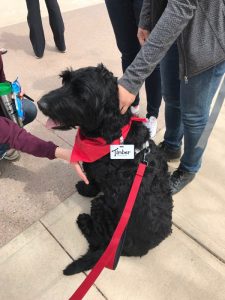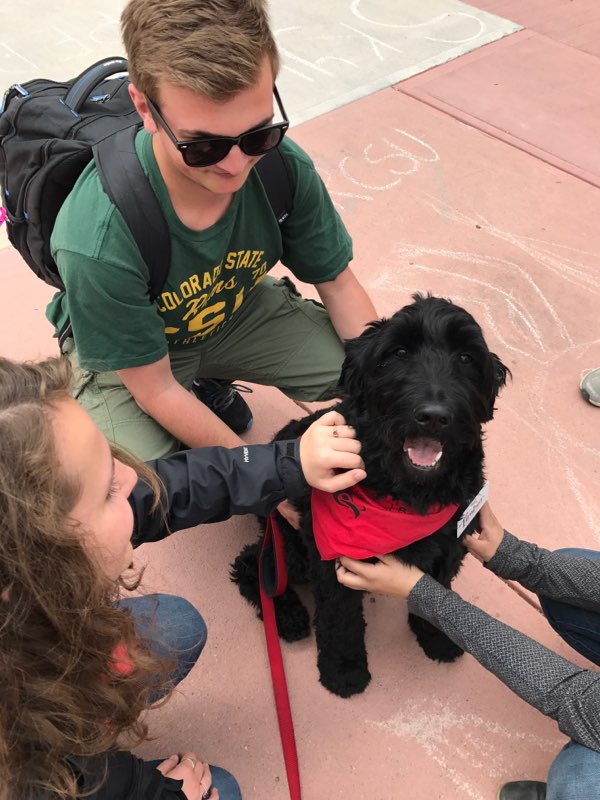You see her before she sees you. You are walking down the street, when you spot the most adorable, fluffy puppy trotting down the street next to her owner. You start to get excited, this is your favorite type of dog! You resist the urge to push past people on the street to close the gap faster. When the eternity of time between you and this adorable floof finally ends, you spit out the words “CanIpetyourdog?” as you descend on the ball of fur. The owner doesn’t object, but there’s one problem, the fluffy puppy is now hiding behind her owner. “It’s ok”, you think, “I love dogs, and I can help her feel better about me!” Your attention sticks with the puppy as she tries to get away, reaching your hands out to “let her sniff”, and cajoling her to come out from hiding under her owner’s legs.
Who benefited from this interaction? I’ll give you a hint: It certainly wasn’t the puppy. This interaction just served to teach that adorable puppy that people are strange and unpredictable, and that her communication about her discomfort will be ignored by her owner and the world around her.
Why do we, as humans, pet dogs anyway? A review of studies in scientific journals found the following about human-animal interactions:
- improvement of social attention, behavior, interpersonal interaction, and mood
- reduction of stress-related parameters such as cortisol, heart rate, and blood pressure
- reduction of self-reported fear and anxiety
- improvement of mental and physical health, especially cardiovascular health

These effects, they proposed, are mediated by the oxytocin system. Oxytocin is associated with childbirth and breastfeeding, but levels also increase in the brain with physical touch in trusting relationships. Increased oxytocin levels have been associated with lower stress and depression. If we can get all these benefits from petting dogs, why shouldn’t we?
The first question we need to ask ourselves is “does the dog want to be petted?” By learning to read dog body language (the Dog Decoder app is a favorite of mine), we will start to learn that there are many dogs out there who don’t want to be petted, at least in certain contexts. Just as there is a difference between hugging your Nana and hugging a stranger, many dogs appreciate attention and petting from their owners, but not a random stranger on the street. Some dogs may want attention from everyone they meet, while other dogs aren’t even comfortable being petted by their owners. Dogs have individual personalities the same as people do, and there is a wide variation in the amount of social contact that dogs desire. We need to be observing the dog’s body language before we approach a dog in public, and most importantly LISTEN! If a dog is showing that they don’t want to be approached by a stranger, don’t approach the dog.
We also need to ask the dog how it would like to be petted, and for how long. Most dogs prefer that you come in low; avoid reaching over their heads, or looming over them with your body. The best way to “ask” a dog if they are enjoying the interaction is to pet the dog for 1-2 seconds, and then pause. Bring your hand back to neutral, and watch the dog’s behavior. Does the dog look relieved that you have stopped petting, or even move away from you? If so, don’t go back for more. If the dog moves toward you, it is soliciting your attention and wants more petting. Repeat this “question” several times while you are petting the dog, pausing to see if they come back for more, or move away. This shouldn’t be reserved for strange dogs, try it on your pup at home and see what they tell you!

Finally, ask yourself “why do I want to pet that dog?” If the answer is to make ourselves feel better, we need to be very sure that we aren’t doing so at the detriment of the dog. If you love petting dogs, and don’t have your own, or your dog doesn’t like petting, consider volunteering to help a therapy dog organization. These are dogs who have been carefully screened, and have proven to enjoy human touch, so that people can get the positive benefits we’ve discussed. Most therapy dog organizations love volunteers to help with their training and certifications, and you will get your oxytocin rush!
It is imperative that we listen to dogs, especially when they tell us they are uncomfortable. Think back to that fluffy puppy walking down the street – next time she encounters a scary situation, she might escalate to a growl or a snap in an attempt to get space, because she wasn’t listened to when she shied away. Next time you see a dog who is nervous about interaction, let them know that some humans are safe, and will listen.
Unless a dog is practically begging you to pet him, think carefully about who benefits from the interaction, and if it is in the dog’s best interest. Even if a dog is begging you to pet him, be thoughtful about what behaviors you might be reinforcing if you pet that dog. Friendly dogs can become very difficult to manage if they believe everyone in the world will pet them, regardless of their behavior. It is often us who benefit from these chance interactions with strange dogs, just take a moment to be sure the dog will benefit as well!


